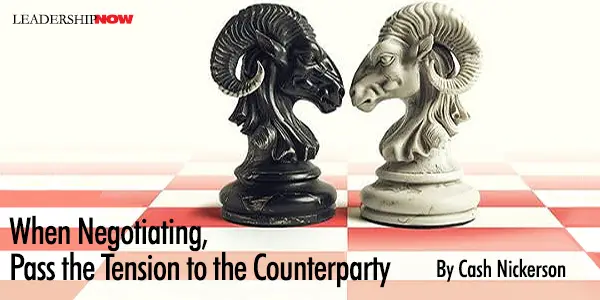When Negotiating, Pass the Tension to the Counterparty
ANYTIME there’s a negotiation, tensions arise. Through my work as a negotiator for over 40 years, I’ve essentially determined seven distinct types of negotiation tension — and have learned to both recognize and manage them to open up a path to progress.
Take, for example, the interplay of seven tensions — including tension around relationship, outcome, process, timing, leverage tension, power, agent, and team — in this particular situation: One of my business partners, and I were approached by a potential buyer of a company we owned. My partner was the majority shareholder, but I had a substantial stake. He was 17 years older than me and retiring soon, so for those reasons, it made sense for him to drive the deal in the background and for me to negotiate it.
He said, “We shouldn’t take less than $100 million.” We didn’t have to sell, and while they didn’t have to buy, we would represent a cheap entry into the US market for this European company. I felt outcome tension over the price. I thought it was too high, given where our results were at the time.
Further, my partner’s plans to retire meant he’d never have to deal with these people again. Given my age and role in the company, I certainly hoped to stay. I liked these folks, and I liked the deal. Hence, my relationship tension. My partner, however, exhibited no tension concerning his future relationship with the potential buyer.
My partner also concluded that it was likely we’d sell the company — and if we didn’t, that was okay with him. So, he also felt no tension concerning the outcome. He was in no rush, so he didn’t experience timing tension either. He also thought these Europeans needed a nice American company to enter the US market, so he felt he had the leverage and, therefore, had no leverage tension.
I, on the other hand, had all those tensions. I wanted to sell, and I was worried too high an anchor would scare them off. As I imagined potentially working with them, a new tension developed within me — agent tension. Should I try to persuade my partner, for whom I was a partial agent, to reconsider our price? I thought about timing. Our company was a large S Corp and, as a result, had a potential temporary reduction in taxes due to the Trump tax cuts. Selling now, before those expired, led to some timing tension. Also, my partner was in his late 70s with no children involved in the business. As a result, I felt the full burden of each of these negotiation tensions in this deal scenario.
Fortunately, tension can be moved from one person to the other. It’s true! Have you ever felt someone’s tension pass to you or passed your tension to someone else? No doubt you have. Say, for example, you’re sitting alone quietly when someone who has tension enters the room. Regardless of how intentional they are in their desire to “share” it, you immediately start to feel it and exhibit it. Knowing this, I was determined to pass my tensions on to the potential buyer.
As we began, I said, “My partner says he won’t sell for less than $100 million, so don’t even think of making an offer at less than that amount. We won’t sign it. After all, the company isn’t for sale. We’re looking at a few good years ahead, so we’re fine. After those years, he’ll retire, and we’ll sell the business then. But if you want to prepare a Letter of Intent (LOI) for a sale at $100 million, we’ll sign it.”
Notice how I quickly addressed the tensions of negotiation. The relationship, outcome, and timing didn’t matter. Leverage on their side was non-existent, and I set forth a process for them. I was off the hook as an agent and had perfect team alignment. I’d gone from all seven tensions to none.
Where was the tension now? They needed a relationship with us. They needed to decide if they could reach our ask. Time and leverage were now on our side. Every one of the seven tensions had been moved to them. And I could feel it.
They were quiet for a few days, and we went about our business. After three days, they called and said, “Okay, let’s draft an LOI for that amount.”
While my partner anchored high, there was much more going on in regard to the seven tensions. Anchoring created tension for me, yet we succeeded in passing the tension on so that the counterparty was left having to grapple with it.

Cash Nickerson is chairman of Nickerson Stoneleigh, Inc., a private investment firm, and President of Cash Nickerson, P.C., a law and negotiation consulting firm. Previously, he was North America Chairman of AKKA Technologies; and President, CFO, and General Counsel of PDS Tech prior to its purchase by AKKA Technologies. Earlier roles include corporate attorney and marketing executive for Union Pacific Railroad, partner at Jenner & Block, and chairman and CEO of a tech company. He has 40 years of negotiation experience and has taught negotiation to law students at Washington University since 2018. He’s authored seven books, including his latest, The Seven Tensions of Negotiation. Learn more at cashnickerson.com.

![]()


Posted by Michael McKinney at 08:36 AM
Permalink | Comments (0) | This post is about General Business




